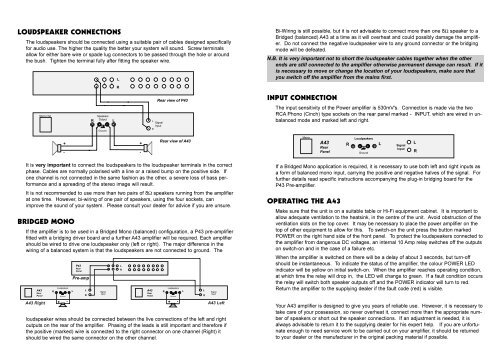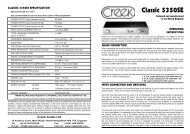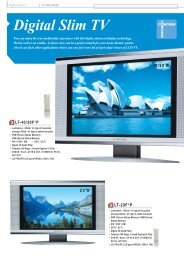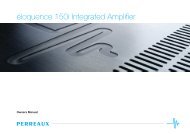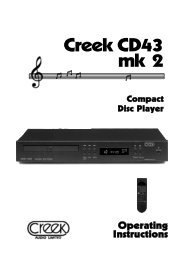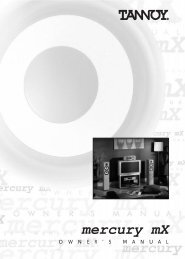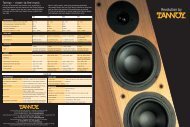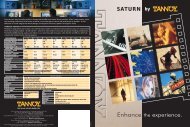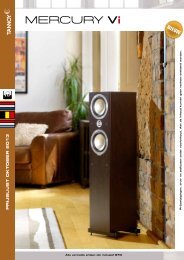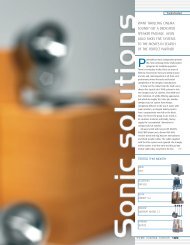Creek A43
Creek A43
Creek A43
You also want an ePaper? Increase the reach of your titles
YUMPU automatically turns print PDFs into web optimized ePapers that Google loves.
LOUDSPEAKER CONNECTIONS<br />
The loudspeakers should be connected using a suitable pair of cables designed specifically<br />
for audio use. The higher the quality the better your system will sound. Screw terminals<br />
allow for either bare wire or spade lug connectors to be passed through the hole or around<br />
the bush. Tighten the terminal fully after fitting the speaker wire.<br />
Mains Inlet<br />
R<br />
1 2 3<br />
Speakers<br />
Output<br />
Ground<br />
L<br />
L<br />
R<br />
L<br />
R<br />
Rear view of P43<br />
Signal<br />
Input<br />
Bi-Wiring is still possible, but it is not advisable to connect more than one 8Ω speaker to a<br />
Bridged (balanced) <strong>A43</strong> at a time as it will overheat and could possibly damage the amplifier.<br />
Do not connect the negative loudspeaker wire to any ground connector or the bridging<br />
mode will be defeated.<br />
N.B. It is very important not to short the loudspeaker cables together when the other<br />
ends are still connected to the amplifier otherwise permanent damage can result. If it<br />
is necessary to move or change the location of your loudspeakers, make sure that<br />
you switch off the amplifier from the mains first.<br />
INPUT CONNECTION<br />
The input sensitivity of the Power amplifier is 530mV's. Connection is made via the two<br />
RCA Phono (Cinch) type sockets on the rear panel marked - INPUT, which are wired in unbalanced<br />
mode and marked left and right.<br />
+<br />
-<br />
+<br />
-<br />
Rear view of <strong>A43</strong><br />
Mains<br />
<strong>A43</strong><br />
Rear<br />
Panel<br />
R<br />
Loudpeakers<br />
Ground<br />
L<br />
Signal<br />
Input<br />
L<br />
R<br />
It is very important to connect the loudspeakers to the loudspeaker terminals in the correct<br />
phase. Cables are normally polarised with a line or a raised bump on the positive side. If<br />
one channel is not connected in the same fashion as the other, a severe loss of bass performance<br />
and a spreading of the stereo image will result.<br />
It is not recommended to use more than two pairs of 8Ω speakers running from the amplifier<br />
at one time. However, bi-wiring of one pair of speakers, using the four sockets, can<br />
improve the sound of your system. Please consult your dealer for advice if you are unsure.<br />
BRIDGED MONO<br />
If the amplifier is to be used in a Bridged Mono (balanced) configuration, a P43 pre-amplifier<br />
fitted with a bridging driver board and a further <strong>A43</strong> amplifier will be required. Each amplifier<br />
should be wired to drive one loudspeaker only (left or right). The major difference in the<br />
wiring of a balanced system is that the loudspeakers are not connected to ground. The<br />
<strong>A43</strong><br />
Rear<br />
Panel<br />
<strong>A43</strong> Right<br />
R<br />
Loudpeakers<br />
Ground<br />
+ -<br />
L<br />
P43<br />
Rear<br />
Panel<br />
Pre-amp<br />
L<br />
R<br />
Signal<br />
Input<br />
1 2 3<br />
L<br />
R<br />
loudspeaker wires should be connected between the live connections of the left and right<br />
outputs on the rear of the amplifier. Phasing of the leads is still important and therefore if<br />
the positive (marked) wire is connected to the right connector on one channel (Right) it<br />
should be wired the same connector on the other channel.<br />
<strong>A43</strong><br />
Rear<br />
Panel<br />
R<br />
Loudpeakers<br />
Ground<br />
+ -<br />
L<br />
L<br />
R<br />
Signal<br />
Input<br />
<strong>A43</strong> Left<br />
If a Bridged Mono application is required, it is necessary to use both left and right inputs as<br />
a form of balanced mono input, carrying the positive and negative halves of the signal. For<br />
further details read specific instructions accompanying the plug-in bridging board for the<br />
P43 Pre-amplifier.<br />
OPERATING THE <strong>A43</strong><br />
Make sure that the unit is on a suitable table or Hi-Fi equipment cabinet. It is important to<br />
allow adequate ventilation to the heatsink, in the centre of the unit. Avoid obstruction of the<br />
ventilation slots on the top cover. It may be necessary to place the power amplifier on the<br />
top of other equipment to allow for this. To switch-on the unit press the button marked<br />
POWER on the right hand side of the front panel. To protect the loudspeakers connected to<br />
the amplifier from dangerous DC voltages, an internal 10 Amp relay switches off the outputs<br />
on switch-on and in the case of a failure etc.<br />
When the amplifier is switched on there will be a delay of about 3 seconds, but turn-off<br />
should be instantaneous. To indicate the status of the amplifier, the colour POWER LED<br />
indicator will be yellow on initial switch-on. When the amplifier reaches operating condition,<br />
at which time the relay will drop in, the LED will change to green. If a fault condition occurs<br />
the relay will switch both speaker outputs off and the POWER indicator will turn to red.<br />
Return the amplifier to the supplying dealer if the fault code (red) is visible.<br />
Your <strong>A43</strong> amplifier is designed to give you years of reliable use. However, it is necessary to<br />
take care of your possession, so never overheat it, connect more than the appropriate number<br />
of speakers or short out the speaker connections. If an adjustment is needed, it is<br />
always advisable to return it to the supplying dealer for his expert help. If you are unfortunate<br />
enough to need service work to be carried out on your amplifier, it should be returned<br />
to your dealer or the manufacturer in the original packing material if possible.


